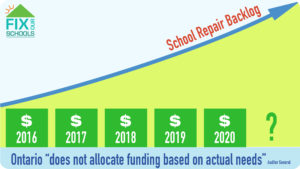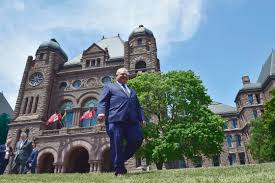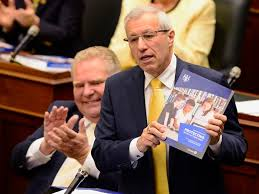On November 5, the Ford government released the 2020-21 Ontario Budget: Ontario’s Action Plan: Protect, Support, Recover. According to OPSBA, education sector funding is projected to be $31-billion with this new budget, an increase of approximately $800-million over last year’s $30.2-billion. While, of course, an increase of $800-million over last year’s budget sounds like a lot of money for the Ford government to allocate for education, let’s consider the following.
The federal government is providing $763.3-million to Ontario specifically to support COVID-safety in schools, which means that actually, the Ford government has chosen to keep its provincial funding for public education virtually the same as last year, despite the fact that this has been and continues to be a completely unprecedented time in the world – and in public education.
In the midst of an even more concerning second-wave of COVID-19, Ontario’s school boards face ongoing unexpected costs to address the reality of public education amidst a global pandemic: additional staffing, IT devices for staff and students, HVAC and air ventilation, PPE, cleaning supplies, caretaker costs, and student transportation to name a few. As economist Ricardo Tranjan bluntly stated, this provincial budget is really bad news for Ontario’s public education system and its schools. Premier Ford and Minister Lecce have been saying for months that their government will spare no expense to ensure that Ontario’s schools are safe. In reality, their government is not making significant investments in public schools and education.
https://twitter.com/ricardo_tranjan/status/1324491092147011584
When Fix Our Schools considered the elements of the provincial budget pertaining specifically to school infrastructure, we were surprised to read in the budget document that the Ford government will provide “$13 billion in capital grants over 10 years to build new schools and renew existing schools across Ontario, to ensure that students have safe and modern education environments in which to learn and thrive. COVID‑19 has underscored the importance of this commitment”.
Using some simple math to divide this $13-billion commitment over 10 years yields a provincial investment of $1.3-billion/year, which, according to the budget document, is meant to cover both building new schools and renewing existing schools. Given that annual provincial funding for only renewal of existing schools has been $1.4-billion/year since June 2016, this announcement in the budget represents a significant proposed cut to provincial funding for schools. Since our provincial government has finally resumed the process of approving new school builds after an almost two-year hiatus, Fix Our Schools simply cannot make the math work on where money will come from for those new school builds if the government is going to continue funding school renewal and repairs at $1.4-billion/year. Again, this smacks of a big cut to funding for public schools.
Premier Ford and Minister Lecce should be ashamed at how little their government is doing to ensure students have safe and modern education environments. Even if 2020 had unfolded in a much more expected manner, Fix Our Schools would have been disappointed in this funding commitment. Given how the COVID pandemic has laid bare the criticality of investing to ensure our schools are safe, healthy, well-maintained buildings that provide environments conducive to learning, we are literally gobsmacked at the lack of real investment the Ford government is making in Ontario’s schools.
The budget also stated that the provincial government will provide “$1.4 billion for the 2020–21 school year for facility repair and renewal, which continues to meet the recommended funding level by the Auditor General of Ontario to preserve the condition of Ontario’s school facilities.”
Firstly, Fix Our Schools was shocked that our provincial government would wish to “preserve the condition of Ontario’s school facilities”, when the repair backlog for these buildings sits at $16.3-billion and wondered why our provincial government would not wish to ensure that, instead, these school buildings were safe, healthy and well-maintained? Secondly, we were shocked by this incredibly disingenuous and out-of-context reference to the following statement from five years ago on page 294-295 of Ontario Auditor-General’s 2015 report (the last time school infrastructure and associated provincial funding were investigated),
“An investment of about $1.4 billion per year based on an industry average of 2.5% of the $55 billion replacement value is estimated to be required to maintain the schools in a state of good repair. But actual annual funding in the last five years had been $150 million a year, increasing to $250 million in 2014/15 and $500 million in 2015/16.” So the Auditor-General’s statement presumes that Ontario’s public schools were in a state of good repair at that time, which they were not. This fact was acknowledged when the 2015 report went on to provide the important context that during the many years when provincial funding has been grossly inadequate, an enormous repair backlog of $14-15-billion had accumulated in Ontario’s schools.
Therefore, if Ontario’s schools were not in a state of good repair in 2015, a provincial government may have expected that if they increased their annual funding to the industry standard of $1.4-billion, perhaps the overall $15-billion repair backlog could be prevented from growing exponentially. However, a reasonable person, considering an old and ever-aging stock of school buildings, could never have presumed that all of a sudden investing the minimum industry standard after almost two decades of providing grossly inadequate funding, would result in eliminating the overall repair backlog to achieve the safe, healthy, well-maintained schools that all Ontario students deserve.
Back in June 2016, when Kathleen Wynne’s government bowed to the pressure Fix Our Schools had been instrumental in creating, and increased renewal and repair funding for schools to $1.4-billion/year, Fix Our Schools was quoted as saying,
“Over the past two decades, Ontario has dug a $15-billion hole of disrepair in our publicly funded schools”, says Krista Wylie, a parent, and co-founder of the Fix Our Schools Campaign. “With this new funding commitment of $1.4-billion/year for school repairs, we’ve stopped the digging but a large hole remains. This Fall, children will still return to aging classrooms with leaking roofs – so we stay committed to working with the provincial government and Ontario’s school boards to ensure we Fix Our Schools.”
At that time, we also called upon the provincial government for a long-term funding plan that would address the $15-billion repair backlog that had accumulated in Ontario’s schools over the past two decades.
So, what do we think Ontario’s Auditor-General would really say today about this $1.4-billion/year provincial funding for school repair and renewal? Well, we believe she would look at the facts, which are simple and as follows:
- Provincial funding for school repairs and renewal was increased to the $1.4-billion cited in the 2015 Ontario Auditor-General report in June 2016, and has been at this level since that time.
- In that same time period, the repair backlog in Ontario’s schools (as measured by a third-party engineering firm, but which does not include portables) has increased from $15-billion to a gobsmacking $16.3-billion, despite this supposed adequate level of provincial funding.

As final support for our argument that Ontario’s Auditor-General would not support the Ford government’s approach to funding schools and education, we cite page 429 of the 2017 Ontario Auditor-General report, the last time that anything to do with public education and schools was examined by her office and look to the following statement:
“Our more significant audit findings are as follows:
• (The Education) Funding formula uses out-of-date benchmarks and is due for a comprehensive external review. In 2002, an independent task force reviewed the Ministry’s complex formula for determining school boards’ funding. The task force recommended that the Ministry annually review and update the benchmarks used in the formula and conduct a more comprehensive overall review of the formula every five years. Fifteen years later, the Ministry has not commissioned another independent review of the (education) funding formula.”
So, the Fix Our Schools campaign believes that the Ontario Auditor-General never suggested that $1.4-billlion/year for school repair and renewal was going to be sufficient to restore Ontario’s schools to be safe, healthy, and well-maintained buildings. And, we are certain that the Auditor-General would not support a provincial funding approach to school maintenance that sees overall disrepair continue to grow at an alarming rate. This is not good public policy. This is not a responsible approach to taking care of public assets. And this is not what Ontario’s students, teachers, and education workers deserve in terms of a learning and working environment. What we believe the Auditor-General would support is a review of the provincial education funding formula that leads to adequate, stable provincial funding for the real needs within our public schools.
 We continued to call on the Ford government to ensure that every publicly funded school in the province is safe, well-maintained, healthy, and provides an environment conducive to learning and working.
We continued to call on the Ford government to ensure that every publicly funded school in the province is safe, well-maintained, healthy, and provides an environment conducive to learning and working.

